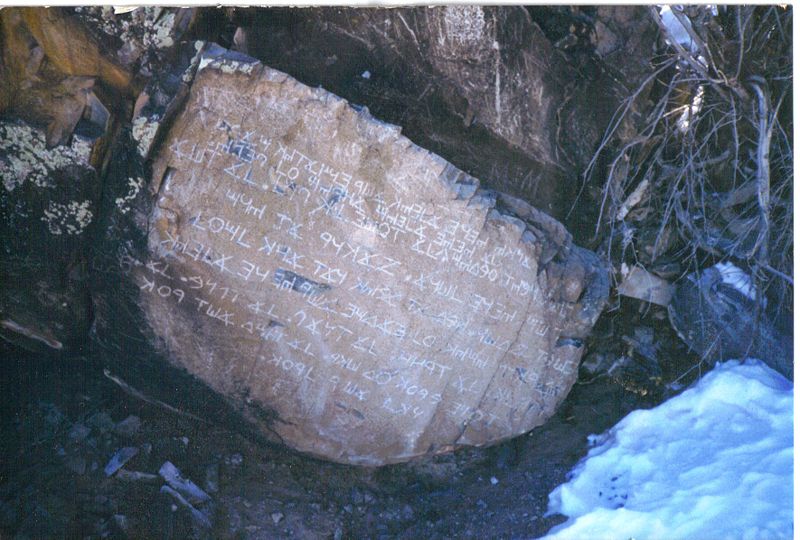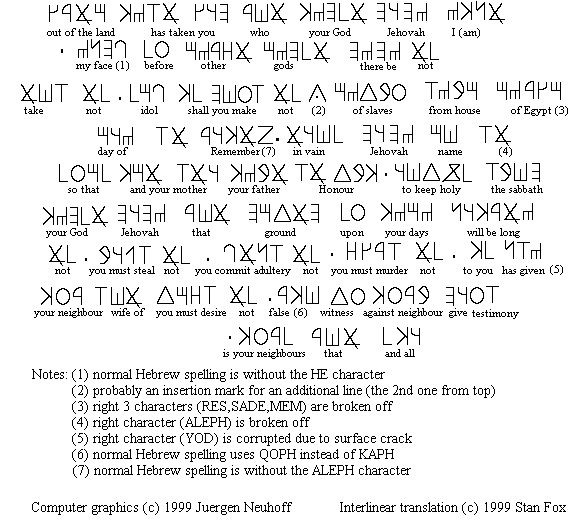The Los Lunas Decalogue Stone
Israelites from the time of Solomon were wandering about America 2500 years before Columbus discovered it for himself. This is found in the Scriptures where King Solomon sent out his ships around the world for 3 years at a time.
1 Kings 10
21 All King Solomon’s goblets were gold, and all the household articles in the Palace of the Forest of Lebanon were pure gold. Nothing was made of silver, because silver was considered of little value in Solomon’s days. 22 The king had a fleet of trading ships at sea along with the ships of Hiram. Once every three years it returned, carrying gold, silver and ivory, and apes and baboons.
The stone inscription is carved in ancient Paleo-Hebrew letters. These are almost identical in shape and font-style with Phoenician characters. Each line in the message is to be read from right to left. In the Hebrew written language there are no vowels. It only uses consonants.
Each statement is separated from the next one by a dot sign. This separation style is not uncommon for old Hebrew or Phoenician inscriptions. E.g. the Middle Eastern Moabite Stone (9th century B.C.E.) follows a similar pattern using dot separators between words.
The Los Lunas inscription starts with the top line, continues on the 3rd line, goes back into the 2nd line (that one was inserted later, hence the smaller line spacing), it then goes on with the left half of the 3rd line and continues all the way down to the last line.
A detailed interlinear translation, which has been compiled from a careful drawing of the Los Lunas inscription, and can be studied below:
Here is a modern-day English translation of the Los Lunas Decalogue:
I am Yahweh your Elohin who has taken you out of the land of Egypt, from the house of slaves. There must be no other elohim before my face. You must not make any idol. You must not take the name of Yahweh in vain. Remember the sabbath day and keep it holy. Honour your father and your mother so that your days may be long in the land that Yahweh your Elohim has given to you. You must not murder. You must not commit adultery. You must not steal. You must not give a false witness against your neighbour. You must not desire the wife of your neighbour nor anything that is his.
According to Wikipedia:
“The Los Lunas Decalogue Stone is a large boulder on the side of Hidden Mountain, near Los Lunas, New Mexico, about 35 miles south of Albuquerque, that bears a very regular inscription carved into a flat panel. The stone is also known as the Los Lunas Mystery Stone or Commandment Rock. The inscription is interpreted to be an abridged version of the Decalogue or Ten Commandments in a form of Paleo-Hebrew. A letter group resembling the tetragrammaton YHWH, or “Yahweh,” makes three appearances. The stone is controversial in that some claim the inscription is Pre-Columbian, and therefore proof of early Semitic contact with the Americas.
The first recorded mention of the stone is in 1933, when the late professor Frank Hibben (1910-2002), an archaeologist from the University of New Mexico, saw it. According to a 1996 interview, Hibben was “convinced the inscription is ancient and thus authentic. He report[ed] that he first saw the text in 1933. At the time it was covered with lichen and patination and was hardly visible. He was taken to the site by a guide who had seen it as a boy, back in the 1880s.”
Deal, David Allen, Discovery of Ancient America, 1st ed., Kherem La Yah Press, Irvine CA, 1984. 1999 3rd Edition available from David Deal at 1651 Monte Vista Drive, Vista, California 92084 or [email protected] for $9.20, P&H included.
Fell, Barry, “Ancient Punctuation and the Los Lunas Text,” Epigraphic Society Occasional Publicatons 13 (1985), 32-43 and cover photo.
Gordon, Cyrus, “Diffusion of Near East Culture in Antiquity and in Byzantine Times,” Orient 30-31 (1995), 69-81.
Leonard, Phillip M., and William R. McGlone, “An Epigraphic Hoax on Trial in New Mexico,” Epigraphic Society Occasional Publications 17 (1988), 206-219.
Lidzbarski, Mark, Letter Chart in Appendix to Wilhelm Gesenius and Emil Kautzsch, Hebräische Grammatik, 27th ed., Leipzig, 1902.
McGlone, William R., Phillip M. Leonard, James L. Guthrie, Rollin W. Gillespie, and James P. Whittall, Jr., Ancient American Inscriptions: Plow Marks or History? Early Sites Research Society, Sutton MA, 1993.
Moorehouse, George E., “The Los Lunas Inscriptions: A Geological Study,” Epigraphic Society Occasional Publicatons, 13 (1985), 44-50.
Neuhoff, Juergen, “Los Lunas Decalogue” website, with translation of inscription by Stan Fox (1999). (URL updated 12/08)
Skupin, Michael, “The Los Lunas Errata,” Epigraphic Society Occasional Publications 18 (1989), 249-52.
Stonebreaker, Jay, “A Decipherment of the Los Lunas Decalogue Inscription,” Epigraphic Society Occasional Publications 10 (1982, part 1), 74-81.
Tabor, James D. “An Ancient Hebrew Inscription in New Mexico: Fact or Fraud?” United Israel Bulletin Vol. 52, Summer 1997, pp. 1-3.
Underwood, L. Lyle, “The Los Lunas Inscription,” Epigraphic Society Occasional Publications 10 (1982, part 1), 57-67.


